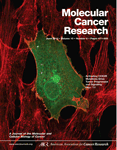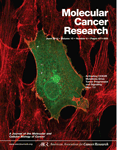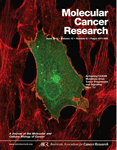Mol Can Res:鳞状细胞癌侵袭转移新标志物α-catulin
2012-07-02 Beyond 生物谷
上皮癌特指来源于外胚层和内胚层,发生于上皮细胞的恶性肿瘤。鳞状细胞癌(SCC)是人上皮癌最常见的类型之一。其中头部和颈部鳞状细胞癌(HNSCC),由于后期诊断死亡率居高不下,淋巴结转移的预后差,是一种最具侵略性的癌症类型。 所有癌症过程的发生,都涉及到局部侵袭和远端器官转移,而这两者与临床上肿瘤患者的生存最相关,但至于肿瘤侵袭转移的分子机制一直得不到良好的解释。 在Molecular Canc
上皮癌特指来源于外胚层和内胚层,发生于上皮细胞的恶性肿瘤。鳞状细胞癌(SCC)是人上皮癌最常见的类型之一。其中头部和颈部鳞状细胞癌(HNSCC),由于后期诊断死亡率居高不下,淋巴结转移的预后差,是一种最具侵略性的癌症类型。
所有癌症过程的发生,都涉及到局部侵袭和远端器官转移,而这两者与临床上肿瘤患者的生存最相关,但至于肿瘤侵袭转移的分子机制一直得不到良好的解释。
在Molecular Cancer Research杂志上的一篇研究论文中,研究人员发现体内蛋白质α-连环蛋白的同源类型物α-catulin的在肿瘤的侵袭转移过程中发挥重要调节作用。敲除hHNSCC细胞株的alpha-catulin后,这些细胞在体外和转移性在体内的迁移和侵袭潜力大大降低。肿瘤α-catulin表达缺失实验分析表明,α-catulin抑制后肿瘤细胞是无法侵入周围基质的。
而
肿瘤转录基因谱研究显示,α-catulin的消融伴随着细胞迁移和侵袭的基因变化。有趣的是,体外实验表明,α-catulin表达的上调与上皮肿瘤细胞间质形态转变,以及上皮细胞间质转型(EMT)的标记物波形蛋白、snail的上调呈相关性。总的来说,研究结果强烈表明α-catulin有助于转移性细胞的侵袭,可作为癌症患者的预后指标和治疗策略。

doi:10.1158/1541-7786.MCR-12-0169
PMC:
PMID:
α-catulin marks the invasion front of squamous cell carcinoma and is important for tumor cell metastasis.
Christine Cao, Yibu Chen, Rizwan Massod, Uttam K Sinha, and Agnieszka Kobielak*
Squamous cell cancers comprise the most common types of human epithelial cancers. One subtype, head and neck squamous cell carcinoma (HNSCC), is a particularly aggressive cancer with poor prognosis due to late diagnosis and lymph node metastasis. Of all the processes involved in carcinogenesis, local invasion and distant metastasis are clinically the most relevant, but are the least well understood on a molecular level. Here we find that in vivo, the α-catenin homologue - α-catulin, a protein originally reported to interact with Lbc Rho guanine nucleotide exchange factor, is highly expressed at the tumor invasion front and in the metastatic streams of cells in both malignant human HNSCCs and a mouse model of oral SCC. Knockdown of α-catulin in hHNSCC cell lines dramatically decrease the migratory and invasive potential of those cells in vitro and metastatic potential in xenotransplants in vivo. Analysis of tumors deficient in α-catulin showed that the tumor cells are unable to invade the surrounding stroma. Accordingly, transcriptional profiling of those tumors revealed that α-catulin ablation is accompanied by changes in genes involved in cell migration and invasion. Interestingly enough, in vitro experiments show that an upregulation of α-catulin expression correlates with the transition of tumor cells from an epithelial to a mesenchymal morphology, as well as an upregulation of EMT markers vimentin and snail. Overall, these results strongly indicate that α-catulin contributes to the invasive behavior of metastatic cells, and may be used as a prognostic marker and future therapeutic target for cancer patients.
本网站所有内容来源注明为“梅斯医学”或“MedSci原创”的文字、图片和音视频资料,版权均属于梅斯医学所有。非经授权,任何媒体、网站或个人不得转载,授权转载时须注明来源为“梅斯医学”。其它来源的文章系转载文章,或“梅斯号”自媒体发布的文章,仅系出于传递更多信息之目的,本站仅负责审核内容合规,其内容不代表本站立场,本站不负责内容的准确性和版权。如果存在侵权、或不希望被转载的媒体或个人可与我们联系,我们将立即进行删除处理。
在此留言














#细胞癌#
52
#标志物#
61